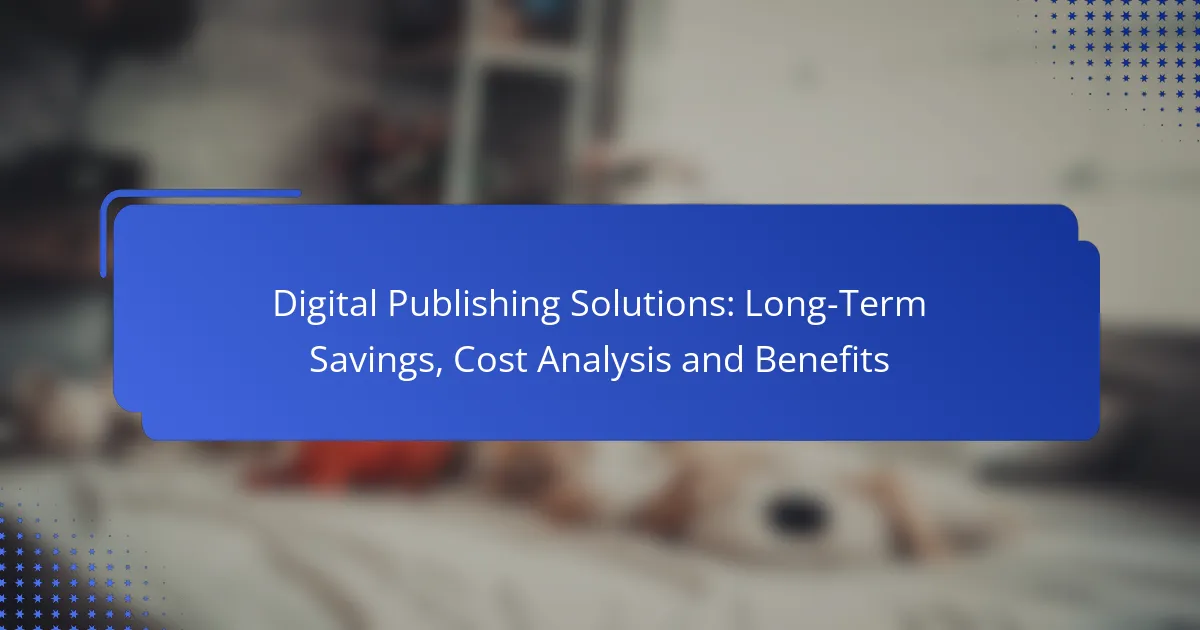Digital publishing solutions present a transformative opportunity for businesses looking to reduce costs associated with traditional publishing methods. By minimizing expenses related to printing, distribution, and storage, these solutions not only enhance operational efficiency but also support scalability for future growth. A thorough cost analysis, including initial setup and ongoing subscription costs, is essential to understanding the long-term financial benefits and return on investment of adopting these innovative tools.

What are the cost-saving benefits of digital publishing solutions in Ireland?
Digital publishing solutions in Ireland offer significant cost-saving benefits by reducing expenses associated with traditional publishing methods. These savings can be realized through lower printing costs, reduced distribution expenses, minimized storage needs, increased operational efficiency, and scalability for growth.
Reduced printing costs
One of the primary advantages of digital publishing is the substantial reduction in printing costs. By transitioning to digital formats, businesses can eliminate expenses related to paper, ink, and printing equipment. This shift not only cuts costs but also allows for more frequent updates without the financial burden of reprinting materials.
For example, companies can save hundreds to thousands of euros annually by opting for digital brochures or e-books instead of printed versions. This is particularly beneficial for organizations that require frequent content updates or have a large volume of materials to produce.
Lower distribution expenses
Digital publishing significantly lowers distribution expenses by eliminating the need for physical shipping and handling. Instead of incurring costs for postage and courier services, digital content can be distributed instantly via email or online platforms, reducing costs to nearly zero.
Moreover, digital distribution allows for broader reach without geographical limitations, making it easier to connect with audiences across Ireland and beyond. This can lead to increased engagement and potential sales without the added expense of traditional distribution methods.
Minimized storage needs
With digital publishing, the need for physical storage space is greatly minimized. Traditional printed materials require significant storage areas, which can lead to additional costs for warehousing and inventory management. Digital files, on the other hand, can be stored on cloud platforms or local servers, significantly reducing overhead costs.
Organizations can save on storage expenses and create a more organized system for managing their content. This efficiency can lead to better accessibility and faster retrieval of materials when needed.
Increased operational efficiency
Digital publishing enhances operational efficiency by streamlining workflows and reducing the time spent on manual processes. Automated tools can simplify tasks such as formatting, editing, and publishing, allowing teams to focus on content creation rather than logistics.
For instance, using digital publishing software can cut production time by up to 50%, enabling quicker turnaround for marketing campaigns or updates. This efficiency not only saves time but also allows for more agile responses to market demands.
Scalability for growth
Digital publishing solutions provide scalability that traditional methods cannot match. As businesses grow, their publishing needs can expand without the corresponding increase in costs associated with printing and distribution. Digital formats allow for easy updates and the addition of new content without significant investment.
This flexibility is crucial for companies looking to adapt to changing market conditions or to launch new products. By leveraging digital solutions, businesses can scale their publishing efforts in a cost-effective manner, ensuring they remain competitive in the evolving landscape.
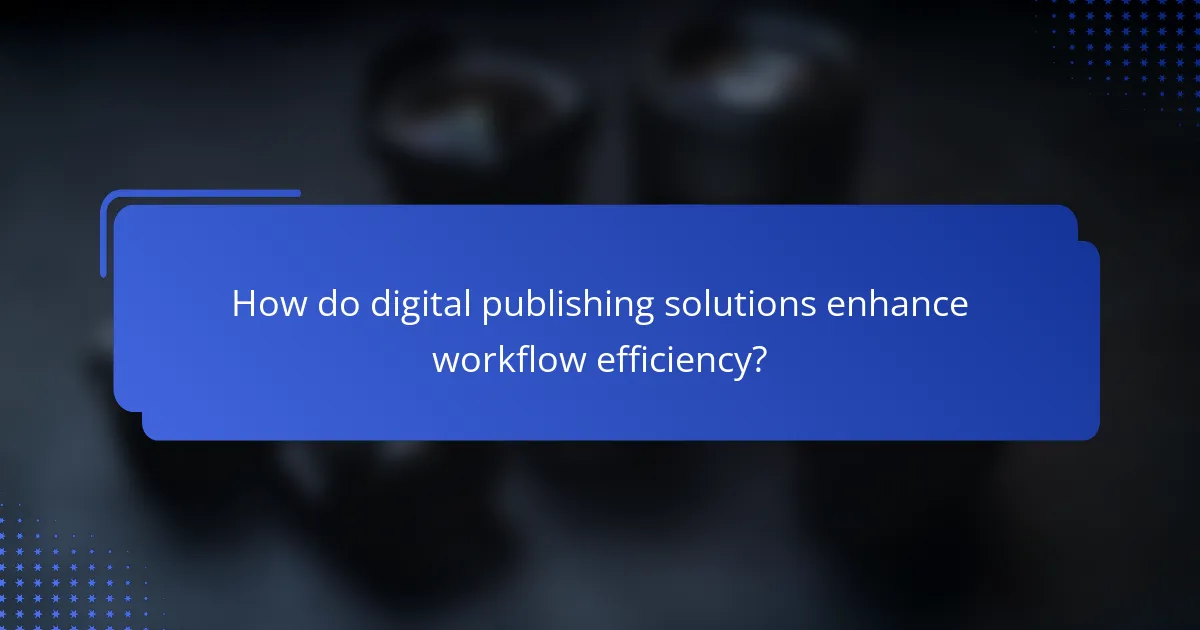
How do digital publishing solutions enhance workflow efficiency?
Digital publishing solutions significantly enhance workflow efficiency by automating repetitive tasks, improving collaboration, and providing instant access to data. These tools streamline processes, allowing teams to focus on content creation rather than administrative duties.
Automated content management
Automated content management systems (CMS) simplify the organization and distribution of digital content. By using templates and predefined workflows, teams can quickly publish updates without manual intervention, reducing the time spent on routine tasks.
Consider implementing a CMS that supports version control and scheduling. This allows for efficient content updates and ensures that the latest information is always available to users. Popular platforms often integrate with existing tools, enhancing overall productivity.
Streamlined collaboration tools
Collaboration tools designed for digital publishing facilitate seamless communication among team members. Features such as shared workspaces, comment threads, and task assignments help ensure everyone is on the same page, reducing miscommunication and delays.
Using tools like Slack or Trello can enhance project management by allowing teams to track progress and deadlines in real-time. Establishing clear roles and responsibilities within these tools can further optimize workflow and accountability.
Real-time updates and analytics
Real-time updates and analytics provide immediate insights into content performance, enabling teams to make data-driven decisions. By monitoring engagement metrics, teams can quickly adjust their strategies to improve reach and effectiveness.
Utilizing analytics tools that integrate with your publishing platform can help identify trends and user preferences. Regularly reviewing this data allows for timely adjustments to content strategies, ensuring that resources are allocated effectively for maximum impact.
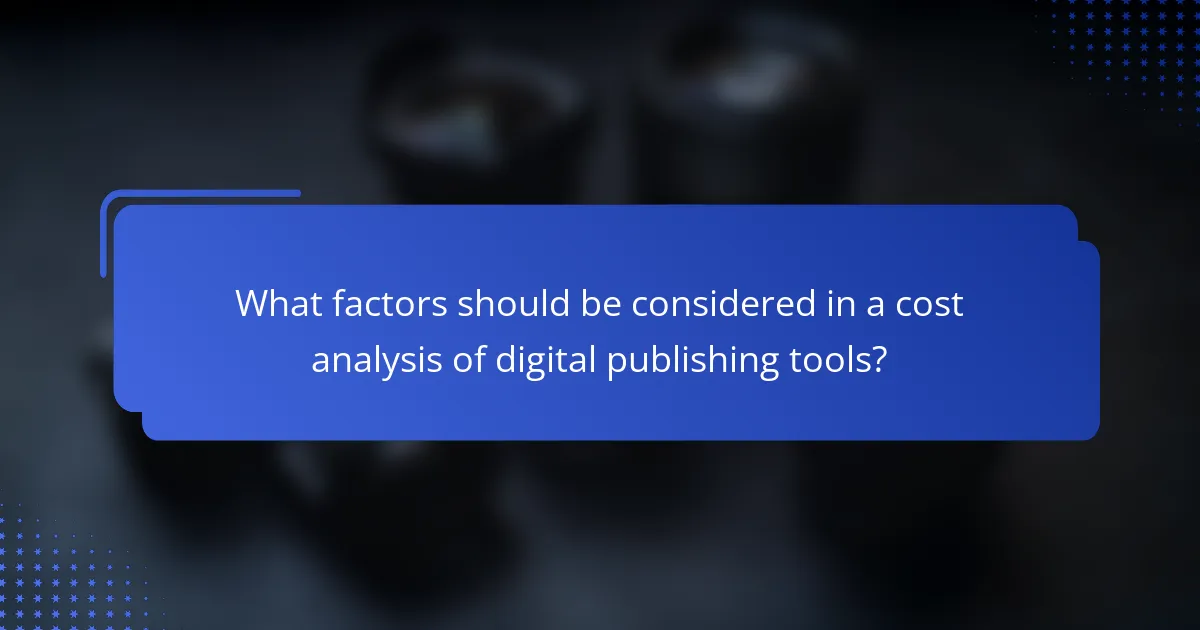
What factors should be considered in a cost analysis of digital publishing tools?
When conducting a cost analysis of digital publishing tools, consider initial setup costs, ongoing subscription pricing models, and long-term return on investment (ROI projections. These factors will help you evaluate the overall financial impact and sustainability of adopting digital publishing solutions.
Initial setup costs
Initial setup costs can include software purchase, hardware upgrades, and training expenses. Depending on the complexity of the digital publishing tools, these costs can range from a few hundred to several thousand dollars. It’s crucial to account for all necessary investments to ensure a smooth transition to digital publishing.
Additionally, consider any potential costs for integrating the new tools with existing systems. This integration may require additional software or technical support, which can further increase initial expenses.
Subscription pricing models
Subscription pricing models for digital publishing tools can vary widely, typically falling into monthly or annual payment structures. Monthly subscriptions may offer flexibility but can accumulate higher costs over time, while annual plans often provide discounts. Evaluate which model aligns best with your budget and usage needs.
Some providers also offer tiered pricing based on features or user access, allowing you to choose a plan that fits your specific requirements. Be sure to compare different providers to find the most cost-effective solution that meets your publishing goals.
Long-term ROI projections
Long-term ROI projections are essential for understanding the financial benefits of digital publishing tools over time. Consider factors such as increased efficiency, reduced printing costs, and improved audience engagement when calculating potential returns. A well-implemented digital solution can lead to significant savings and revenue growth.
To estimate ROI, track key performance indicators (KPIs) such as user engagement rates and publication frequency. Regularly reviewing these metrics will help you adjust your strategy and maximize the financial benefits of your digital publishing investment.

Which digital publishing platforms are popular in Ireland?
In Ireland, popular digital publishing platforms include Adobe InDesign, Canva, and WordPress. Each platform offers unique features that cater to different publishing needs, from professional design to user-friendly content management.
Adobe InDesign
Adobe InDesign is a leading desktop publishing software widely used for creating print and digital media. It is particularly favored by professionals for its advanced layout capabilities and integration with other Adobe products.
When using InDesign, consider its learning curve, as it may require some time to master. However, the investment in skills pays off with high-quality outputs suitable for magazines, brochures, and eBooks.
Canva
Canva is a web-based design tool that simplifies the publishing process with its drag-and-drop interface. It is ideal for users who may not have extensive design experience but want to create visually appealing content quickly.
Canva offers a range of templates and design elements, making it easy to produce social media graphics, presentations, and marketing materials. While it may lack some advanced features of InDesign, its accessibility and cost-effectiveness make it a popular choice among small businesses and individuals.
WordPress
WordPress is a powerful content management system that enables users to create and manage websites and blogs. It is particularly popular for its flexibility and extensive plugin ecosystem, allowing for various digital publishing needs.
When using WordPress, consider its ease of use for non-technical users and the ability to customize sites with themes and plugins. It is suitable for everything from personal blogs to professional portfolios, making it a versatile option for digital publishing in Ireland.
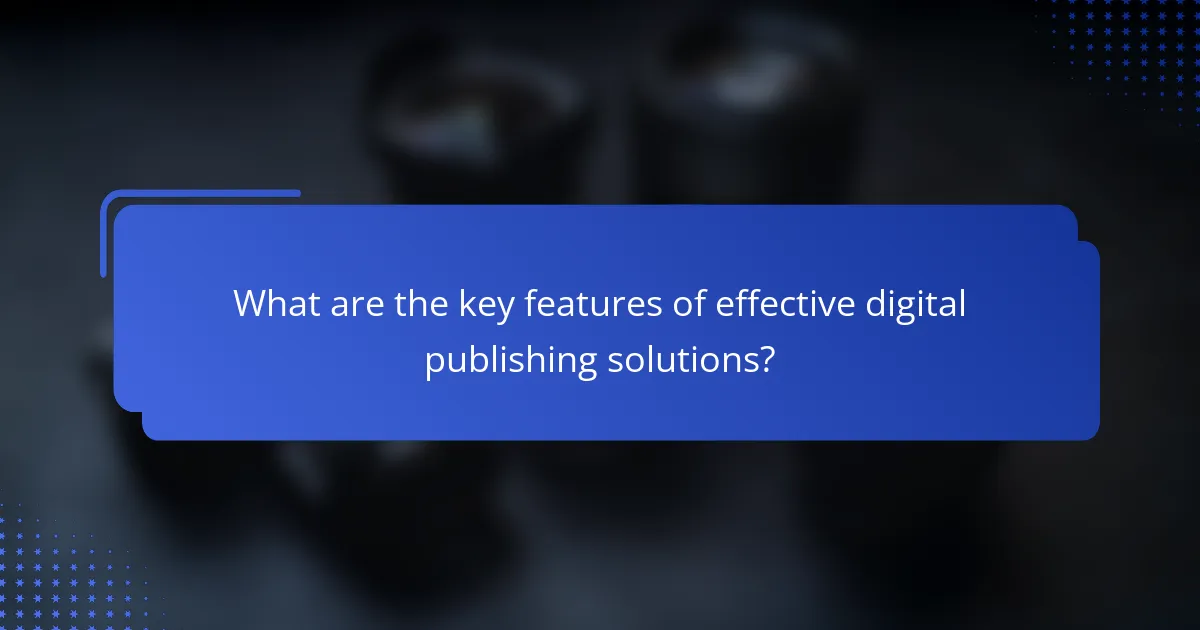
What are the key features of effective digital publishing solutions?
Effective digital publishing solutions encompass various features that enhance content delivery and user engagement. Key aspects include responsive design, integration with analytics tools, and user-friendly interfaces, all of which contribute to a seamless experience for both publishers and readers.
Responsive design capabilities
Responsive design ensures that digital content adapts to different screen sizes and devices, providing an optimal viewing experience. This feature is crucial as users access content from smartphones, tablets, and desktops, making it essential for publishers to cater to diverse platforms.
To implement responsive design effectively, consider using flexible layouts, scalable images, and CSS media queries. This approach not only improves user satisfaction but can also positively impact search engine rankings, as search engines favor mobile-friendly sites.
Integration with analytics tools
Integrating analytics tools allows publishers to track user behavior, engagement metrics, and content performance. This data is invaluable for making informed decisions about content strategy and marketing efforts.
Popular analytics tools include Google Analytics and Adobe Analytics, which provide insights into user demographics, page views, and average session duration. By leveraging this data, publishers can optimize their content and tailor their offerings to meet audience preferences.
User-friendly interfaces
A user-friendly interface is vital for enhancing the reader’s experience and encouraging interaction with the content. Intuitive navigation, clear calls to action, and accessible design elements contribute to a positive user experience.
When designing a user interface, prioritize simplicity and clarity. Avoid cluttered layouts and ensure that essential features, such as search functions and subscription options, are easily accessible. This approach can lead to higher user retention and satisfaction rates.
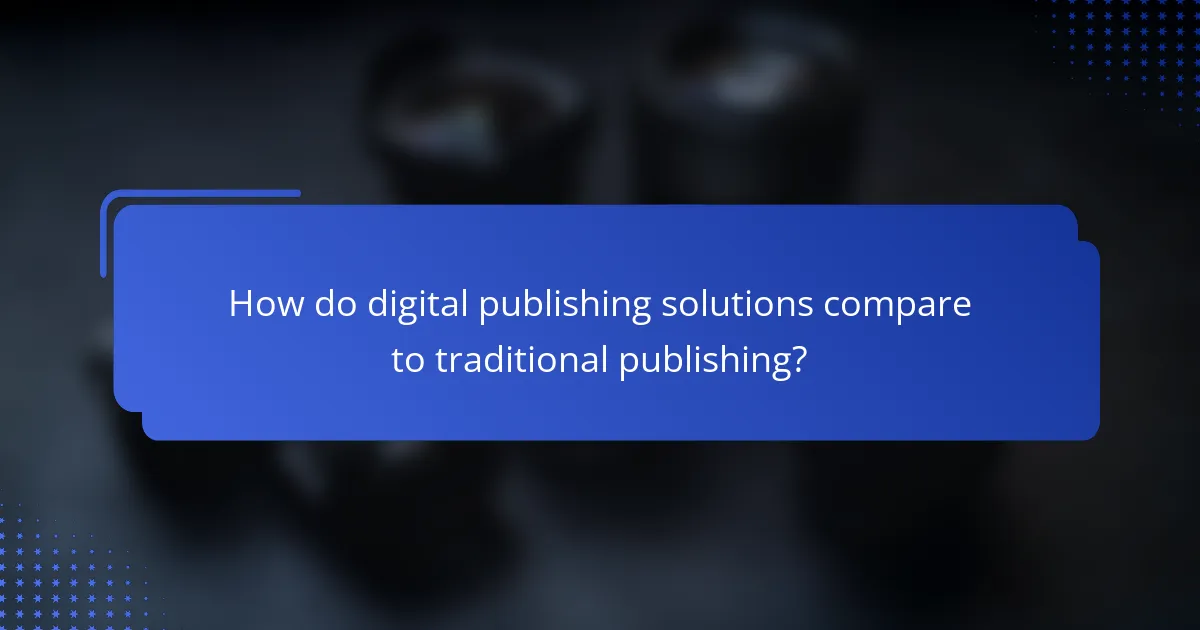
How do digital publishing solutions compare to traditional publishing?
Digital publishing solutions offer significant advantages over traditional publishing, primarily in cost efficiency and speed. They eliminate many physical production costs and streamline distribution, making them a more economical choice for many publishers.
Long-term savings with digital publishing
Digital publishing can lead to substantial long-term savings compared to traditional methods. By reducing costs associated with printing, storage, and shipping, publishers can allocate resources more effectively. For instance, the elimination of print runs can save thousands of dollars annually, especially for smaller publishers.
Additionally, digital formats allow for easy updates and revisions, which can further reduce costs over time. Instead of reprinting entire editions, publishers can simply update content online, saving both time and money.
Cost analysis of digital versus traditional publishing
When analyzing costs, consider both direct and indirect expenses. Direct costs for traditional publishing include printing, paper, and distribution, while digital publishing primarily incurs costs for software, hosting, and digital marketing. A typical digital publishing setup may range from a few hundred to several thousand dollars, depending on the complexity of the platform.
Indirect costs, such as labor and time spent on production, also differ significantly. Digital publishing often allows for quicker turnaround times, which can lead to increased revenue opportunities through faster market entry.
Benefits of digital publishing solutions
The benefits of digital publishing extend beyond cost savings. Enhanced accessibility is a key advantage, as digital content can be accessed from various devices, reaching a wider audience. This flexibility is crucial in today’s fast-paced digital landscape.
Moreover, digital publishing allows for interactive content, such as videos and hyperlinks, which can engage readers more effectively than traditional print. This interactivity can lead to higher reader retention and satisfaction, ultimately benefiting publishers in the long run.
